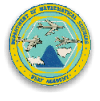






|

Mathematica Notebook Library
Multivariable Calculus
-
Chain Rule (8K)
-
Demonstrates how to use Mathematica to compute derivatives using the chain
rule in a multivariable setting.
-
Conservative Fields, Potential Functions,
Independence of Path (15K)
-
A demonstration-type notebook that shows how to test if a vector field
is conservative, compute the potential function, and evaluate line integrals
using the Fundamental Theorem of Line Integrals all in both 2D and 3D.
-
Contour Animations (9K)
-
Illustrates the concept of contour maps and their relationship to the 3D
plot of z = f(x,y) using animations.
-
Divergence Theorem (8K)
-
A demonstration-type notebook that shows how to evaluate 3D flux integrals
through closed surfaces using the Diveregence Theorem of Gauss.
-
Euler's Method and Vector Field Flow
(31KB)
-
discusses Euler's method and the approximation of flow lines in vector
fields. Contains applications to free fall and to pendulum motion.
-
The Gradient (36KB)
-
discusses the relationship between the gradient and a level curve.
Contains an application to heat-seeking missiles.
-
Gradients and Direction Derivatives
Demonstration (12K)
-
A demonstration-type notebook that shows and explains how to define functions
of several variables, plot them, compute their gradients and magnitudes
of their gradients in general and at specific points, compute directional
derivatives, and plot gradient fields.
-
Green's Theorem (6K)
-
A demonstration-type notebook that shows how to compute a line integral
over a closed path in 2D using Mathematica.
-
Lagrange Multipliers (25KB)
-
introduces root-finding algorithms in Mathematica. Then, discusses
the use of the method of Lagrange multipliers in an application specific
to the Air Force Academy.
-
Lagrange Multipliers Demonstration
(12KB)
-
demonstrates how to use the Method of Lagrange Multipliers to solve constrained
optimization problems using both the Solve command to find exact solutions
and the FindRoot command to approximate solutions for tougher equations.
-
Line Integrals (10K)
-
A demonstration-type notebook that shows how to evaluate a variety of line
integrals in Mathematica and shows how to graph a path through a 2D or
3D vector field.
-
The Monte Carlo Method (26KB)
-
discusses the Monte Carlo method as a numerical method for approximating
the values of multiple integrals. Contains an application to weapon
effectiveness.
-
Morphing Surfaces (16K)
-
Demonstrates how to use the concept of a homotopy to "morph" one 3D surface
to another. Suggestions are provided on how this idea could be used
in an undergraduate multivariable calculus setting to help encourage students
to better understand the graphs of z = f(x,y) in a fun and entertaining
way.
-
Parameterizations (44KB)
-
introduces the ParametricPlot command. Distinguishes between a given
parameterization and the underlying curve through animations.
-
Parameterized Paths Illustrated (57K)
-
Provides a wide variety of plotting and animation functions for illustrating
the concepts of parameterized curves, position vectors, velocity vectors,
and acceleration vectors.
-
Parameterized Surfaces (5K)
-
Provides an example of plotting parameterized surfaces with Mathematica.
-
Second Partial Derivatives (9K)
-
Demonstrates how to compute second order partial derivatives using Mathematica.
-
Stokes' Theorem (9K)
-
A demonstration-type notebook that shows how to evaluate both the line
and surface integrals that arise from Stokes' Theorem.
-
Surface Integrals (9K)
-
A demonstration-type notebook that shows how to evaluate surface integrals
using Mathematica. Also, shows how Mathematica can help determine
the limits of integration for the corresponding double integral and how
to visualize the surface.
-
Tangent Planes (5K)
-
Illustrates the concept of a tangent plane to the surface produced by z
= f(x,y) using 3D graphics.
-
Three-Dimensional Riemann Sums (9K)
-
Illustrates the concept of 3D Riemann Sums as approximations for double
integrals both graphically, using animations, and numerically.
-
Vector Fields, Divergence, and Curl (12K)
-
A demonstration-type notebook that shows how to define and plot vector
fields (2D and 3D), compute divergence of a vector field in general and
at a specific point, compute curl of a vector field in general and at a
specific point, and how to plot a vector field with a contour plot of its
divergence for conceptual discussion.
-
Visualizing Functions of Two or More Variables
(375KB)
-
introduces Plot3D, ContourPlot, and animations (for functions of 3 variables)
as tools for visualizing functions.
Back to Mathematica Notebook Library Main Menu.
For any questions regarding this page please contact
the
webmaster.dfms@usafa.af.mil.
This page last updated: 1 June 00
|



